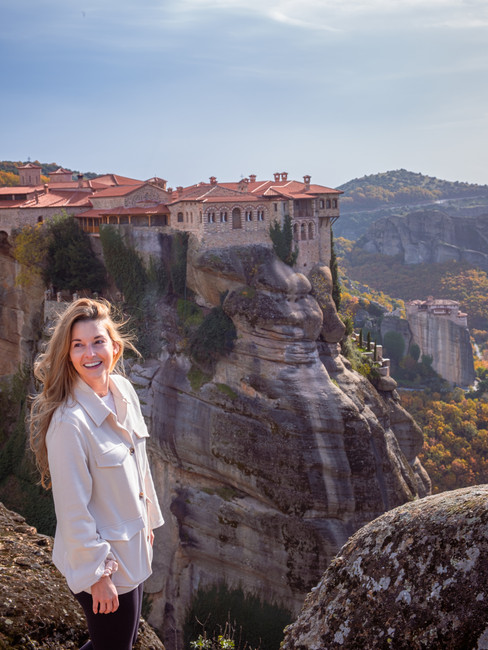- whitneykamerzel
- Dec 14, 2023
- 7 min read
Updated: Nov 27, 2024
Meteora: Your Quick Travel Guide to
Navigating the Monasteries

Nestled in the heart of mainland Greece, the enchanting region of Meteora is a testament to both nature's grandeur and human ingenuity. A UNESCO World Heritage Site, Meteora is famed for its towering rock formations that seem to touch the heavens. However, what truly sets this place apart is the collection of monasteries perched precariously atop majestic rocks. We agreed this was probably the coolest thing we've EVER seen in our lives! In this travel guide, we'll provide you with essential insights for exploring the mystical monasteries. Skip to the end for a simple three day itinerary.
Meteora's history dates back to the 14th century when monastic life flourished in the region, mainly as a method of protection for monks and Christians seeking to escape persecution from the Ottoman occupation. At this time, Christian emperors held only a small territory of what used to be a vast empire. Seeking protection, monks chose these seemingly impregnable rocks as their sanctuary. Over the centuries, a total of 24 monasteries were built, although only six remain active today. The name "Meteora" means "suspended in the air," aptly describing the otherworldly appearance of these monastic complexes.
The name "Meteora" means
"suspended in the air" in Greek.
About the Monasteries:
Great Meteoron Monastery: Kick off your Meteora adventure with the largest and oldest monastery, Great Meteoron. Built in the mid-14th century, it provides a captivating introduction to the region's spiritual and historical significance. It requires about 300 steps to reach, and will have the most people, but it is truly worth the effort.
Varlaam Monastery: Perched on a cliff opposite Great Meteoron, Varlaam offers breathtaking panoramic views. Accessible via a bridge, the monastery is a visual treat, showcasing religious artifacts and stunning frescoes. 140 steps.
Roussanou Monastery: With a more feminine touch, Roussanou is dedicated to St. Barbara. Reaching this monastery involves a moderate climb, and the effort is rewarded with exquisite frescoes and a serene atmosphere. 140 steps.
St. Nicholas Anapafsas Monastery: Known for its strategic location, this monastery is perched atop a rock accessible by a relatively short flight of steps. It provides a glimpse into the monastic way of life and offers spectacular views. 140 steps.
Monastery of St. Stephen: Easily accessible by road, St. Stephen's is the most accessible monastery and offers a unique blend of monastic life and a museum-like setting. It's an excellent choice for those with limited time or physical constraints.
Holy Trinity Monastery: As one of the most challenging to reach, Holy Trinity requires a climb of around 300 steps. The effort is justified by the unrivaled views of the surroundings and the feeling of accomplishment upon arrival. This was actually our favorite monastery (not Great Meteoron like you would expect), maybe because of the garden with towering cyprus trees and because there were very few people.
Day One
Day One Recommended Order of Visit:
Begin your journey with Great Meteoron (go as early as possible to avoid the crowds) to grasp the historical context and witness the grandeur of the first and most famous monastery.

Next, cross the valley to Varlaam and Roussanou, exploring their unique architectural and artistic features. Continue with St. Nicholas Anapafsas before concluding your visit at the Holy Trinity Monastery, saving the most challenging climb for last. If time is a constraint, the Monastery of St. Stephen can be visited at any point because it is so easy to get to, offering a convenient and captivating experience.

You will find that it is very difficult to visit all six in one day. Don't feel like you have to see them ALL in order to check Meteora off your list. Just be present and bask in the wonder of the ones you are able to get to and you will have no regrets. All of them close by around 2 PM, so head back to your hotel to rest until sunset.
Note: The monasteries are only open on certain days of the week and at certain times. They can be found by clicking here. Make sure to look this up before you go.
Sunrise and Sunset Photo Viewpoints: The best (and usually most busy) place to enjoy the Meteora sunset is the Sunset Rock viewpoint tagged as "Viewpoint Meteora" in Google maps - it could not be easier to find!!! It is the only viewpoint offering you views of five out of six monasteries. Our second choice would be the "Main Observation Deck of Meteora" tagged in Google Maps to visit for sunrise, but that means waking up early ;) Most of the photography on this page was taken at Great Meteora Monastery during the day or Sunset Rock at sunset.

How Many Days Should You Stay? A lot of tour companies try to sell a one day trip to Meteora from Athens. Because they are four hours apart by car I would leave this as a last resort. This would be an excruciatingly long travel day with only the opportunity to see one or two monasteries at peak visiting times. We recommend you stay at least one night. We stayed three nights (with two active days) and found that this was plenty. If you stay longer, you can do more hiking or check out the surrounding villages.
Note: There are a number of road tolls if you are driving yourself to Meteora using the fastest route. Equip your phone with apple pay or the Android equivalent so you can breeze through or bring around 20 euros in cash.
Hotels and Where to Stay: I put a lot of time into deciding between Kastraki and Kalambaka. Kastraki is smaller, quieter, and gives off "peaceful, authentic, village" vibes. The hotels are boutique style. Some websites told me it would be hard to find places to eat but we visited in mid-December and had several fantastic eating options! It is closer to the monasteries.
Kalambaka has a bigger town with more eating and hotel options, including larger chains. Overall, they are so close together that I regret thinking so much into which town to stay in. Just choose based on hotel options and how close you want to be!
Best Luxury Hotel: Doupiani House (Kastraki)
Best Boutique Hotels: Tsikeli (Kastraki) or Holy Spirit (Kastraki)
Best Cheap Hotel: Kosta Famissi (Kalambaka)
Best for Families: Monastiri (Kalambaka) or Petrino (Kastraki)
Best for Hikers: Vavitsas (Kastraki) or Mythos (Kalambaka)
Best Pool & Reliable Chain Hotel: Divani (Kalambaka)
We stayed in Tsikeli and it was a 10/10 for us. They have a restaurant on-site that came in handy when we wanted to hang out for a drink without going too far. This also meant the (free!) breakfast was all handmade by the chef. We said it was the best hotel breakfast we've ever had.
Day Two: Hiking or Guided Tour
Hike Meteora: Embarking on a hiking tour around Meteora unveils a truly authentic experience, immersing you in the footsteps of the religious pilgrims and monks who once treaded these sacred paths. This was the highlight of our Meteora trip. We did the half day hiking tour (located here) with Chris at Visit Meteora and it was some of the best hiking we've ever done. It's already inexpensive, but you can unlock the small group discount with a group of only three!

Although it was several hours long, it actually felt less strenuous than visiting the monasteries solo the day before and we were led to some truly incredible viewpoints that are inaccessible on the main monastery strip. For instance, we visited the hidden monastery of Ypapanti (shown above) that is now inactive. Plus, our guide was able to give us the history of the area and tell us about the vegetation and animals we came across. Did you know there are white and black truffles buried in this area and some are worth thousands of dollars?

Take a Guided Tour - If hiking isn't your thing, no worries! We would still recommend taking a guided tour of the monasteries with Visit Meteora. They have several on their website (located here) and some can be tailored to your group officially by email ahead or unofficially if you ask your guide in person. During the winter months you might find your group to be the only ones on the group tour ;)
Restaurants: Because visiting Meteora is more about the sights than the food, specific tavernas may not be open during some times of the year and accommodations are so varied geographically, this is one of those places you want to get recommendations from a local, your hotel, or your tour guide. Don't be afraid to explore off the beaten path!
Overall, we left Meteora thinking that the monasteries were portals to an ancient era. It felt indescribable and momentous and powerful. We repeated over and over that this was one of those "once in a lifetime" places that only a few are able to visit. We hope you enjoy your visit as much as we did!
Below is the simple itinerary we made to keep us on track. We kept travel on their own days, leaving two full days for actively exploring Meteora.
Simple Itinerary:
Day One: Travel Day
Grab lunch and drive to Meteora in the afternoon (4 hours from Athens)
Dinner: by local recommendation
Hotel: Tsikeli in Kastraki
Day Two: Main Monastery Day
Breakfast at hotel - eat big there's only snacks for sale at the monasteries.
Wake up and visit the first Monastery, Great Meteoro, as early as possible. Next visit Varlaam, Roussanou, St. Nicholas Anapafsas, Holy Trinity Monastery, and St. Stephen or as many as you can before 2 PM
Head back to hotel until sunset
Sunset: visit "Viewpoint Meteora" in Google maps to take photos on the rocks for sunset.
Dinner: by local recommendation
Hotel: Tsikeli in Kastraki
Day Three: Guided Tour
Breakfast at hotel
8:30 AM half day hiking or monastery guided tour - you can visit any monasteries you still have left or soak up the beauty of a hike
Shop in the towns or relax at a cafe or your hotel
Dinner: by local recommendation
Hotel: Tsikeli in Kastraki
Day Four: Travel home or to next destination
Many people tack on a trip to Arachova either before or after their Meteora visit. Coming soon: our Arachova Travel Guide.
There may be affiliate links within this post which provide me with a commission, at no cost to you. This is a way to help me to provide valuable content. As always, thanks for your support.
























